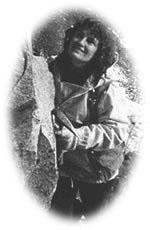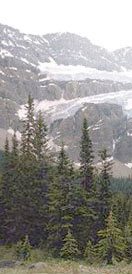|
NRCan Home > About Us > Trailblazers > Dr. Catherine Hickson

Trailblazer
Dr. Catherine Hickson
1955 -
 A young rock collector A young rock collector
Little did Dr. Catherine Hickson know that her childhood fascination with rocks would lead her to a career as one of the world's foremost authorities on volcanoes.
"On summer vacations with my family, I collected rocks in such places as the Grand Canyon, Yellowstone National Park and other parts of the United States and Canada," said Catherine, now a volcanologist with Natural Resources Canada's Geological Survey of Canada (GSC) in Vancouver. "I had hundreds of them when I was a kid. I had always been interested in geology, and I had done huge projects on it - especially about volcanoes - but I never considered it a potential career."
Because she was unaware of career possibilities in earth sciences, Catherine began studying recreation, and then psychology, at the University of Alberta. After one year, she transferred into the psychology program at the University of British Columbia (UBC), where she was required to take more science courses for her degree. She chose a course in geology, thus rekindling her passion for rocks and taking the first step toward her calling.
The woman who would
Although women were rarely visible in the scientific field in the 1980s, particularly in earth sciences, Catherine was encouraged to pursue her studies to the Ph.D. level by supportive professors who recognized her abilities.
She did graduate work under Jack Souther and Bill Mathews, scientists with the GSC's Geothermal Energy Program. She would work with Souther again as part of the Young Scientists Program, which identified new young talent to shadow seasoned veterans in the same field before they retired.
The lure of the God of Fire
A self-described "volcanic sleuth," Catherine focused on gaining expertise in volcanology and mapping. "I try to understand the volcano - how it evolved and how it formed. I put together a whole bunch of pieces of a puzzle and answer questions."
The eruption of Mount St. Helens in 1980 was the pivotal event in her professional life. Although the academic community was buzzing with talk of the potential eruption, no one knew when it would take place. By coincidence, she was there for the momentous occasion. The experience of Mount St. Helens solidified the God of Fire's grip on Catherine - volcanology was her calling.
Crossing borders
Since that time, Catherine has moved up in the ranks of volcano experts with many scientific papers to her credit. In 1995 she was selected to lead the GSC's Vancouver regional office, and in 1996 was asked to lead the Multinational Andean Project (MAP). This geoscience project, whose partners included Argentina, Bolivia, Canada, Chile and Peru, aimed to locate new mineral wealth and help create sustainable communities.
 |
| Dr. Catherine Hickson in the field in southern Ecuador (near the town of Puyango) looking at a very large petrified tree trunk preserved in cretaceous sediments. The area is preserved as a park. (July 2004) |
In the final two years of MAP, Catherine conceived and implemented the Multinational Andean Project: Geoscience for Andean Communities (MAP:GAC).
"We're doing technology transfer with our partner countries, the seven Andean nations (Argentina, Bolivia, Chile, Colombia, Ecuador, Peru and Venezuela), and establishing best practices on how one conveys information to communities about natural hazards such as volcanoes, earthquakes and landslides," she said. Her work on these projects earned her the respect of her peers, and in 1999, the Head of the Public Service Award.
Leading by example
In addition to her work with the international community, Catherine also finds time to be a positive role model here at home. "I've been part of several mentorship programs over the years," she said. "I saw the important role that my mentors played while I was going through university. I experienced the positive impact of these people first-hand and hoped I could have the same effect on someone else."
Catherine has focused her mentoring efforts on women in science and on young managers. "Women are in the minority, and there are special considerations with them," she explained. "I want to help some young aspiring women pursue scientific careers and take on leadership roles within their professions."
She was also one of the founding members of the Science and Innovators in the Schools program at UBC and has led numerous workshops and field trips for teachers. "I'm a firm believer in ‘teach the teachers,'" Catherine stated. "I could go out every day and talk to school kids, but teachers connect with hundreds of children year after year; they can reach a wider audience."
Through these initiatives, Catherine is achieving her goals of enhancing the public's understanding of volcanoes and the contributions of the volcanologists who study them - and encouraging young women to pursue careers in science.
Life Achievements
- 1982 - Graduated from UBC with B.Sc., Honours, cum laude
- 1987 - Graduated from UBC with Ph.D.
- 1987-1988 - Post-doctoral work with the Queen Charlotte Islands Frontier Geoscience Project
- 1988 - Hired by GSC under the Young Scientists Program
- 1989 - Project Leader, Taseko Lakes Project
- 1995-2002 - Subdivision Head, GSC, Vancouver
- 1996 - Adjunct Professor, UBC
- 1996-2002 - Manager, MAP
- 1999 - Recipient of the Head of Public Service Award
- 2002 - Manager, MAP:GAC
More Trailblazers
|



